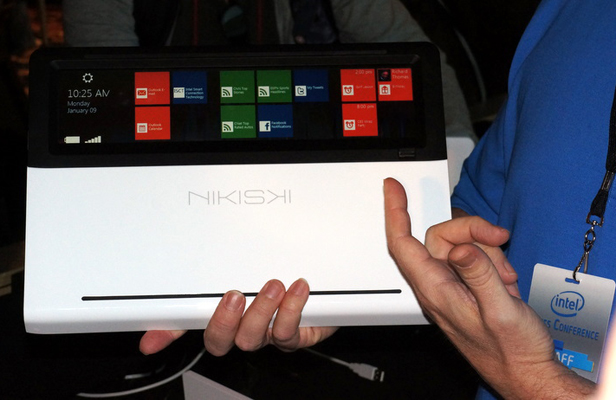At the Consumer Electronics Show in Las Vegas today, chip maker Intel refreshed the familiar notebook computer with ideas borrowed from more glamorous competitors.
Touch, voice control, and even gesture control—the latter popularized by Microsoft’s Kinect gaming controller—will be coming to lightweight laptops dubbed “ultrabooks,” said Mooly Eden, Intel’s vice president for sales and marketing, at Intel’s press conference this morning.
Intel dominates the market for desktop, laptop, and server processors, but has been a spectator to the rapid growth of smart phones and tablets. Worse for the Santa Clara, California, chip maker, high-powered smart-phone and tablet processors based on designs from U.K.-based ARM are beginning to show potential in Intel’s traditional realm.
This story is only available to subscribers.
Don’t settle for half the story.
Get paywall-free access to technology news for the here and now.
Subscribe now
Already a subscriber?
Sign in
Smart phones, tablets, and Apple’s super-lightweight MacBook Air have made conventional laptops look rather staid in recent years, threatening a major source of revenue for Intel. Eden’s presentation made it clear that Intel has spent considerable effort in its labs developing new technologies to refresh the notebook. Touch, voice recognition, and novel hybrid tablet-laptop designs have all been developed and will be licensed to partners such as Asus, Acer, and HP, which make ultrabooks.
Eden also showed a brief demonstration of an ultrabook able to recognize hand and arm gestures made in front of its screen, using software developed by Intel. A simple game involved using a slingshot, operated by extending an arm into the space in front of the ultrabook, making a grasping motion in thin air, then pulling back and releasing to fire the catapult. “We believe that we’ll see gestures even with our ultrabook,” said Eden. He didn’t explain how the technology worked but the ultrabook appeared to have a normal camera, suggesting it was using machine vision software to process video from its webcam.
Eden presented all those new twists on the notebook as logical moves enabled by more power-efficient processors and by a better appreciation of the importance of human-machine interaction. “In the last 30 years, the number of transistors went up a million percent, but we didn’t do enough with the man-machine interface,” he said.
There was no reason for touch to have appeared in phones and tablet devices but not laptops, said Eden. “Let me tell you something, it’s not going to skip the ultrabook,” he said. Trials in Europe, the U.S., China, and Brazil involving prototype ultrabooks with touch screens have found that people used the touch panel for around 70 percent of operations, he said. Eden also dismissed claims that people would find operating a touch panel in a notebook tiring: “People say that it’s very easy.”
Eden was dismissive of tablets, labeling them devices well suited to consuming movies and other content, but not to doing work or creating content. Intel’s anthropologists had discovered that being able to do both is important, he said. “People don’t buy the story that consumption is enough,” Eden said. “We are people; consumption is for cows.”
Eden also showed ultrabooks with designs halfway between phone and tablet. The screen of one design, which he described as a “slider,” could be moved over the keyboard to become a tablet. A prototype called a Nikiski has a large, transparent touch pad that stretches the full width of the device. When a Nikiski laptop is closed, some of its screen is visible through that touchpad, providing easy access to notifications like calendar events or e-mails. When open, the panel can detect when a person places his hands down to type on the keyboard.
The Nikiski prototype was shown running the forthcoming Windows 8 operating system. It includes a special interface, known as Metro, which presents notifications and access to programs using a grid of tiles intended to be swiped and tapped. It was originally designed for touch devices. “We’ll be able to get an even better [touch] experience with the tile experience,” said Eden.
Peter Mahoney, chief marketing offer for Nuance, which develops voice recognition technology, joined Eden to announce that future ultrabooks will be able to recognize voice commands in a manner similar to Apple’s Siri assistant, which is built into the iPhone 4S.
Nuance’s technology is licensed by Apple for use in Siri, but Mahoney said that voice control could be more powerful in an ultrabook because the devices have more computing power than phones do. Unlike Google or Apple’s voice recognition, there will be no need for speech data to be sent to cloud servers for analysis, he said, leading to quicker performance. The software can also adapt to a person’s voice and even relatively thick accents, he said. The feature will initially support nine languages: English, French, German, Italian, Dutch, Spanish, Brazilian Portuguese, Japanese, and Mandarin.
Eden said that the voice feature could be used to compose social-media messages and updates, and to ask a closed laptop in a person’s bag for information with questions such as “when is my next meeting?”
There are more than 75 ultrabook devices “in the design pipeline” for 2012, said Eden, and a handful will launch with touch screens before the year is out. Analysts at the Consumer Electronics Association, which organizes CES, estimate that Intel’s various partners will launch more than 50 regular ultrabooks this week.
Although Intel says ultrabooks will be the company’s main focus in 2012, the company is also working to gain a foothold in phones and tablets, and recently showed prototypes expected to be seen again at CES later this week.
